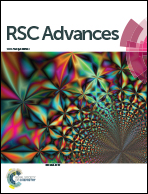Titanium phosphonate oxo-alkoxide “clusters”: solution stability and facile hydrolytic transformation into nano titania†
Abstract
Titanium (oxo-) alkoxide phosphonate complexes were synthesized using different titanium precursors and tert-butylphosphonic acid (tBPA) as molecular models for interaction between phosphonates and titania surfaces and to investigate the solution stability of these species. Reflux of titanium(IV) ethoxide or titanium(IV)(diisopropoxide)bis(2,4-pentadionate) with tert-butylphosphonic acid in toluene–ethanol mixture or acetone yielded seven titanium alkoxide phosphonate complexes; [Ti5(μ3-O)(μ2-O)(μ-HOEt)2(μ-OEt)3(μ2-OEt)(μ3-tBPA)3(μ3-HtBPA)(μ2-tBPA)2(μ2-HtBPA)]·3EtOH, 1, [Ti4O(μ-OEt)5(μ2-OEt)7(μ3-tBPA)], 2, [Ti4(μ2-O)2(μ-OEt)2(μ-HOEt)2(μ2-tPBA)2(μ2-HtPBA)6]·4EtOH, 3, [Ti4(μ2-O)2(μ-OEt)2(μ-HOEt)2(μ2-tPBA)2(μ2-HtPBA)6]·2EtOH, 4, [Ti6(μ2-O)(μ3-O)2(μ2-OEt)5(μ-OEt)6(μ3-tBPA)3(μ3-HtBPA)], 5, [Ti4(μ-iOPr)4(acac)4(μ2-tBPA)4], 6 and [Ti5(μ4-O)(μ2-O)3(μ2-OEt)4(μ-OEt)6(μ-HOEt)(μ3-tBPA)]2, 7. The binding mode of tBPA to the titanium oxo-core were either double or triple bridging or a combination of the two. No monodentate or chelating coordination was observed. 31P NMR spectrometry of dissolved single crystals indicates that 1 and 5 retain their solid-state structures in solution, the latter even on moderate heating, while 6 and 7 dissolved into several other forms. The complexes were found to be sensitive towards hydrolysis, proceeding in a topotactic fashion with densification of the material into plates and lamellae resulting finally in “core–shell” nanoparticles with a crystalline core (anatase) and an amorphous outer shell upon contact with water at room temperature as observed by HRTEM and AFM analyses. 31P NMR data supported degradation after addition of water to solutions of the complexes. Hydrolysis under different conditions affords complex oxide structures of different morphologies.



 Please wait while we load your content...
Please wait while we load your content...